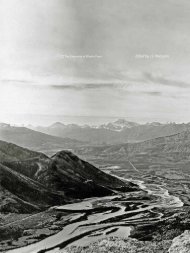C Ihe Ladies c cu. V'VVAN - History and Classics, Department of
C Ihe Ladies c cu. V'VVAN - History and Classics, Department of
C Ihe Ladies c cu. V'VVAN - History and Classics, Department of
- No tags were found...
Create successful ePaper yourself
Turn your PDF publications into a flip-book with our unique Google optimized e-Paper software.
Notes to Pages 62-63 263porpoise or <strong>of</strong> a sperm-whale, the pursuit in a kayak, thecasting <strong>of</strong> the harpoon, the cetacean's writhings <strong>of</strong> pain, <strong>and</strong>his spurtings <strong>of</strong> blood-tinted water. (Savoie I,I93)Depending upon how widespread the parti<strong>cu</strong>lar melody <strong>of</strong> thechanting was among Inuit groups, the tune heard by Vyvyanmight have been the one recorded in Alaska by CharlesH<strong>of</strong>fman as "Song <strong>of</strong> the Seal" (23); another possibility mightbe that Ikagena enacted in dance the story <strong>of</strong> "The Man with aScourge <strong>of</strong> Bearded-Sealskin," which Knud Rasmussenrecorded in I924 (Ostermann I30-32). "The Drum Dance"<strong>of</strong>fers a salutary brief description <strong>of</strong> the drum dance, <strong>of</strong> whichthe seal dance is one example (O'Connell).cotton dresses or fur-lined parkas with hoods ... One oldIIlan wore two labrets in his lower lipAlaskan Inupiat <strong>cu</strong>ltural practices, including clothing styles,came to the Inuvialuit <strong>of</strong> the Mackenzie Delta with the whalingtrade in the late-nineteenth century. Generally, it had beentraditionally the case that "the man's parka served as ametaphoric reference to the animal <strong>and</strong> to the man's role ashunter; the woman's parka, with its characteristic pouch (amaut) ,in which the wearer carried her infant, symbolized the maternalrole <strong>of</strong> the woman" (Driscoll 176). On the new style <strong>of</strong> parka,made from caribou, "the hood was trimmed with wolverineinstead <strong>of</strong> white caribou fur. The white insets on the side <strong>of</strong> thehood were smaller than on the old style. The white chest panelswere replaced with tusk-like white-haired sections sewn on eachside <strong>of</strong> the centre front. ... These pieces are symbolic <strong>of</strong> walrustusks. Walruses are honored for their strength <strong>and</strong> aggressivebehavior. The new parka's hemline was about mid-thigh length.Instead <strong>of</strong> being <strong>cu</strong>t straight across, the hem <strong>cu</strong>rved upwards atthe hips. An authentic tail <strong>of</strong> the caribou was attached to thebacks <strong>of</strong> parkas; ... parkas were <strong>of</strong>ten trimmed with whitecaribou hair or wolverine" (Oakes <strong>and</strong> Pointe 102). While acolour illustration <strong>of</strong> the full man's outfit that Vyvyan likely sawis reproduced in Driscoll (180), it is noteworthy that Vyvyan'sphotographs <strong>of</strong> the interpreter, Billie Kemaksina, <strong>and</strong> <strong>of</strong> anunidentified woman at Aklavik show, respectively, shorter <strong>and</strong>longer versions <strong>of</strong> this design (see above, 59,62). The exaggerated"sunburst" effect <strong>of</strong> the trim around the hood <strong>of</strong> the parkaseems to have been a later development (Oakes 8).As to the cotton seen by Vyvyan on garments, Oakes <strong>and</strong>Pointe note that "the Alaskan Inupiat through traders obtainedbrightly colored fabric which was used to make a cloth shell for askin parka. This style is <strong>cu</strong>rrently known as the 'MotherHubbard'. The Delta Inuvialuit, due to their interaction withthe Alaskan Inupiat, were introduced to this colorful parkashell .... One way <strong>of</strong> displaying economic status [as a successfultrapper] was to make the Mother Hubbard several inches longerthan the skin outer parka. When wearing the outer parka, thefabric inner parka was visible designating one's ability to obtaintrade goods" (102). Versions <strong>of</strong> these cotton garments apparentlyare represented in Dorrien Smith's watercolour sketch <strong>of</strong>Inuit outside a summer tent residence (see above, 196), <strong>and</strong> aphotograph by Vyvyan appears in Arctic Adventure. One account <strong>of</strong>the inter-racial contact that issued in this fashion oc<strong>cu</strong>rs inPursuing the Whale, about the winter <strong>of</strong> 1900-01, which Capt JohnCook <strong>and</strong> his wife, "the first <strong>and</strong> only white woman to winter asfar north <strong>and</strong> east" (221). spent in the Bowhead. an Americanwhaler, <strong>of</strong>f Baillie Isl<strong>and</strong>. north -east <strong>of</strong> the Mackenzie Delta,As winter advanced. the Eskimo women became moreacquainted with Mrs Cook <strong>and</strong> used to come aboard askingher to teach them how to sew calico. or cloth, for they callall cloth "calico," <strong>and</strong> they in turn would teach Mrs Cook tosew skins <strong>and</strong> furs, to make rugs <strong>and</strong> clothing. Althoughthey quickly acquired the art <strong>of</strong> sewing clothing, Mrs Cookcould not seem to stitch furs equal to them; <strong>and</strong> when hersewing <strong>of</strong> furs was examined by them, how they would laugh!(221)Labrets are "buttons made <strong>of</strong> ivory worn as ornaments <strong>and</strong>inserted into <strong>cu</strong>ts in the lower lip on either side <strong>of</strong> the mouth,"but Archibald Fleming goes on from this description (294) tosuggest that they were uncommon at Bernard Harbour by1928, so it is perhaps not surprising that Vyvyan noticed thatan "old" man wore them; in his book the next year. Rasmussenmade the same observation (Across facing 292). EthnographerDerek Smith explains that, among Inuvialuit, "paired cheeklabrets were worn by men after puberty. These were usuallymade <strong>of</strong> polished stone or ivory, <strong>and</strong> in late times were ornamentedwith blue glass bead insets" (252).one old wOIllan who, as I learned later, was reputed to be awife <strong>of</strong> the explorer StefanssonAccording to Georgina Stefansson, who was a fifth-gradestudent at Inuvik Federal School in 1961. this woman was
















